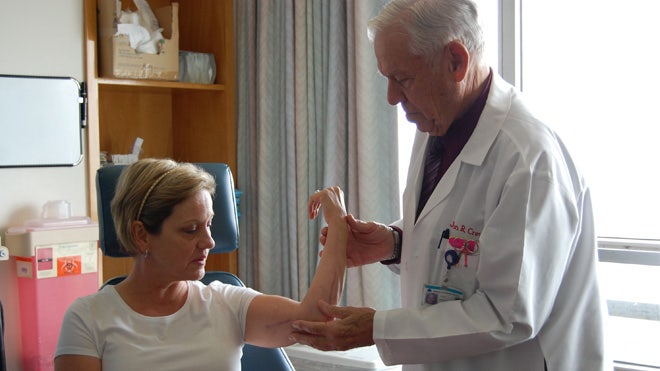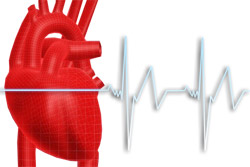
In January 2012, Lori Madsen, then 51, was walking through a parking lot, when she fell and skinned her arm. Initially, she didn’t think much about the rugburn-like abrasion on her arm – but later that night, Madsen’s arm began to swell.
Two days later, the pain was so bad she couldn’t get out of bed.
“My husband had to take me to the ER and my blood pressure wasn’t reading and everything was shutting down,” Madsen told FoxNews.com. “I was in septic shock.”
Madsen was admitted to the intensive-care unit, where the infection in her arm raged on – causing fevers, blistering and swelling. A week later, Madsen was taken into surgery for the first time.
“They opened my arm up for the first time and excised some of the dead tissue in there,” Madsen said. “I got better for a couple days. My fever went down, but then I took another turn for the worse.”
At this point, Madsen feared she would lose her arm – or even worse – her life. Finally, she was introduced to Dr. John Crew, a vascular surgeon and wound specialist at Seton Medical Center in Daily City, Calif., where she was receiving treatment. Crew told Madsen he might know what was causing her health problems: A deadly disease known as necrotizing fasciitis.
The flesh-eating disease
Necrotizing fasciitis, commonly known as the flesh-eating disease, results from a bacterial infection and rapidly destroys the body’s soft tissue. The condition garnered national attention in 2012, when 24-year-old Aimee Copeland underwent a quadruple amputation after contracting necrotizing fasciitis in the aftermath of a zip lining accident.
Typically, necrotizing fasciitis is treated with antibiotics and surgical excision of the infected areas of the body. Though rare, the disease can carry a fatality rate of up to 70 percent – and those that survive are often left with devastating handicaps due to loss of limbs.
“They excise (the dead tissue), and (sometimes) you excise the hands and the legs and that’s a lousy way to end up,” Crew said.
Desperate to save Madsen’s limbs and life, Crew, director of the hospital’s Advanced Wound Care Center, devised a plan in which he would excise the dead tissue from Madsen’s arm and then regularly irrigate the area with an FDA-approved wound cleanser called NeutroPhase. Crew is a paid consultant for NovaBay Pharmaceuticals, the company that manufactures NeutroPhase, and he had been using the product to sterilize wounds for many years. NeutroPhase contains hypochlorous acid, a common chemical disinfectant.
“Hypochlorous acid is produced by the body’s white blood cells when it fights infection,” Dr. Harvey Himel, medical director of the wound program at Icahn School of Medicine at Mount Sinai in New York City, told FoxNews.com. “(It) is one of the common chemicals found to purify water in swimming pools and is used as a disinfectant in food preparation.” Himel was familiar with the study, but not involved in Madsen’s treatment.
Luckily, Madsen’s initial surgical treatment –coupled with the NeutroPhase irrigation – appeared successful.
However, six days later, Crew noticed another infected spot in a different area on Madsen’s arm. This time, Crew decided to simply insert a catheter and irrigate the area with NeutroPhase – without performing surgery to excise any more of the tissue in her arm.
Remarkably, this area of Madsen’s arm healed just as quickly as the area that underwent the standard surgical excision. Additionally, using NeutroPhase bypassed the severe scarring that now covered much of the rest of her limb.
Madsen noticed a difference in her condition almost immediately after being treated by Crew.
“Before they started NeutroPhase, the pain was unbearable. You can’t describe the way the pain is, and the fever I had was just unbelievable,” Madsen said. “But then, after they started the NeutroPhase and started killing all of the toxins in my arm, the fever subsided and went away. The pain wasn’t as bad…It wasn’t the kind of pain that you feel when it’s infected, and your arm is dying.”
‘People don’t have to lose their limbs or their lives’
Madsen eventually made a full recovery, and while she sustained some nerve damage in her arm, she has regained full function in the limb and now lives a normal life.
After Madsen’s recovery, Crew set out to discover what it was about NeutroPhase that had halted the infection.
“We had to go back to the lab after Lori was healed,” Crew said. “They isolated five or six of the toxins involved in this kind of necrotizing fasciitis, and individually, they treated cells in the lab… and it killed them.”
Crew and his fellow researchers discovered that NeutroPhase seemed to effectively neutralize the toxins produced by the infection, halting the body’s inflammatory-reaction and allowing the patient to begin to heal normally.
Crew recently published his findings in the peer-reviewed journal,Wounds, and he hopes to convince other doctors to begin using NeutroPhase to treat necrotizing fasciitis. Since Madsen’s case, Crew said he has successfully treated several other patients with necrotizing fasciitis using NeutroPhase – even avoiding surgery, in some cases.
“I had one 95-year-old, (and) when I just put in a catheter and irrigated it with NeutroPhase, she healed from that standpoint,” Crew said. “We didn’t need a big massive operation to drain or excise necrotic tissue. We’re looking to tell people this is the way to treat this problem. We won’t make big massive incisions, but small incisions to get the irrigation going as quick as we can.”
Himel warned that while this case appeared to be successful, more research is still needed.
“Since this is a single case report, it is hard to say if this treatment was instrumental in the patient’s recovery,” Himel said. “In order to scientifically prove the value of this additional treatment, they would need to conduct more extensive research.”
For Madsen, her hope is that this treatment will eventually help prevent others in her situation from going through the same agony she did.
“I don’t want to see anyone go through what I went through. I want the word out there that this stuff works on this necrotizing fasciitis,” Madsen said. “People don’t have to lose their limbs or their lives.”
Source: inagist










 The Centers for Disease Control and Prevention (CDC) states that around 715,000 Americans suffer a heart attack every year. Now, scientists have created a new imaging technique that could identify which patients are at high risk. This is according to a study published in the The Lancet.
The Centers for Disease Control and Prevention (CDC) states that around 715,000 Americans suffer a heart attack every year. Now, scientists have created a new imaging technique that could identify which patients are at high risk. This is according to a study published in the The Lancet.
